Dell Adamo 13: CULV Goes Upscale
by Vivek Gowri on July 6, 2010 1:51 AM ESTDell Adamo 13: Display Analysis
The LCD display of the Adamo is pretty sweet. It has a Gorilla Glass screen, which is an alkali-aluminosilicate thin sheet glass that is used to protect screens on mobile devices. Gorilla Glass is also used on the Motorola Droid, the Dell Streak, and a device from Apple that nobody's ever heard of, the newly released iPhone 4. Basically, this means that even with such a thin display which may not offer the most protection for the screen, this chemically hardened glass covering will ensure that the screen sustains no scratches or damage of any kind.
Which is all pretty cool, but what about the quality of the panel itself? The first impression is that this thing gets BRIGHT. At maximum brightness, you're looking at a white level of 389 nits. That's just about on par with the Apple MacBook Pro line, which have some of the higher quality notebook displays we've tested recently.
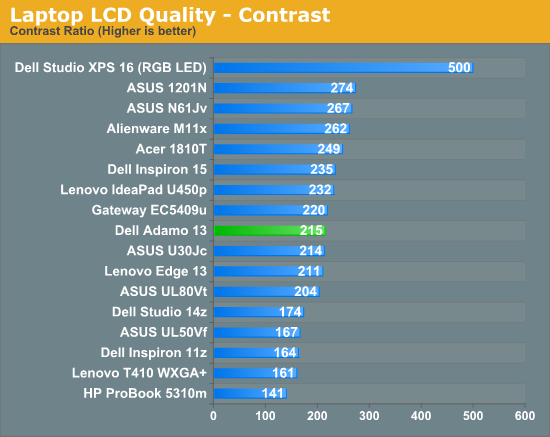
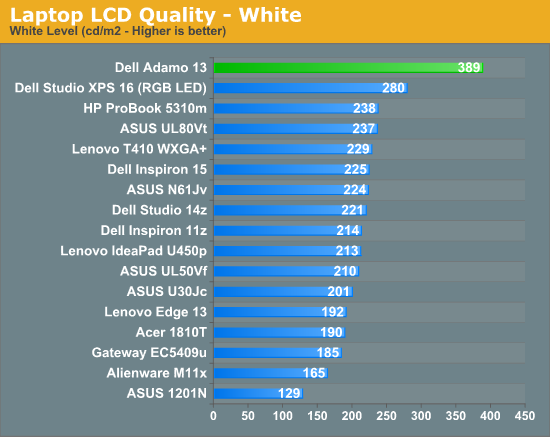
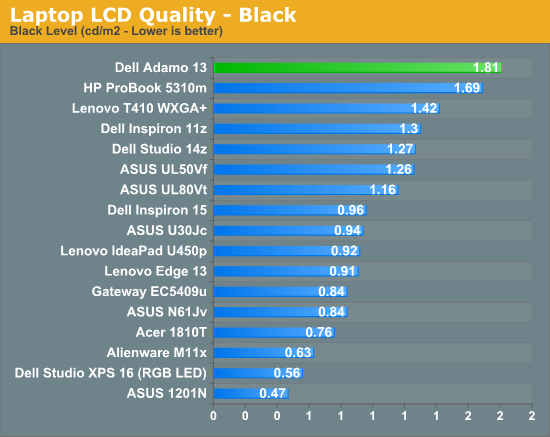
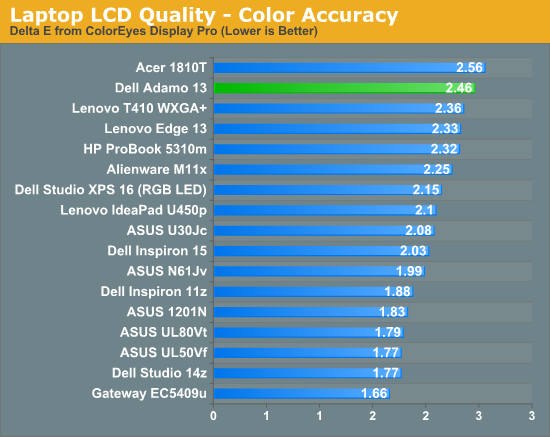
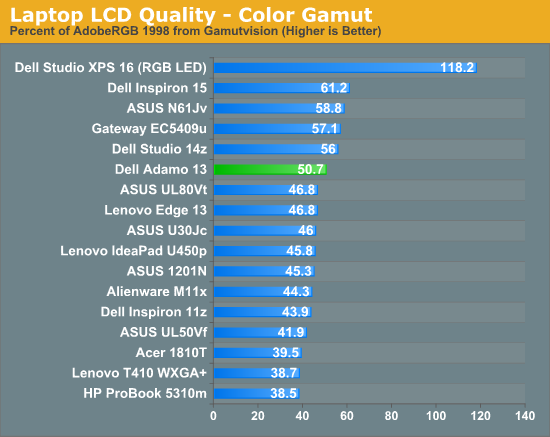
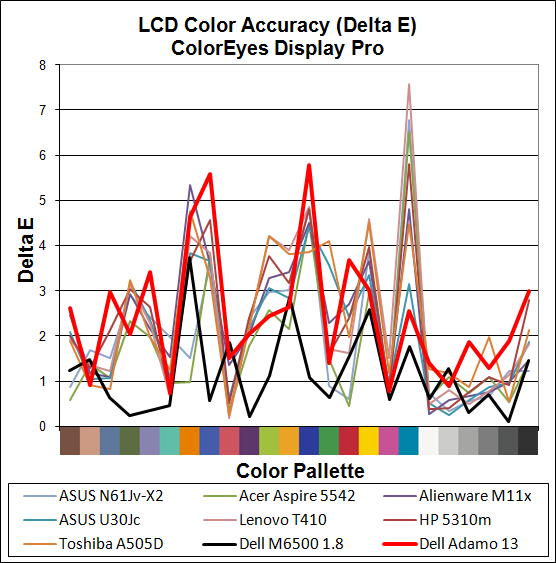

However, the display falls off after that, with contrast ratio just about average and unspectacular color accuracy. And though the white level is pretty high, the black level is just as high, so at the upper brightness levels, the screen can appear washed out. Colour accuracy and colour gamuts are pretty mediocre but aren't terrible. Really though, the screen's brightness is it's trump card, and overall, the display looks pretty good, even with the reflective glass covering the display.










67 Comments
View All Comments
MrSpadge - Tuesday, July 6, 2010 - link
You might want to take a look at the new Thinkpad X201 using Core iSomething.Stokestack - Tuesday, July 6, 2010 - link
Except for the glossy screen. Glossy screens are the biggest regression in personal computing ever.The current fraud of glossy screens originated with third-tier products being peddled at Best Buy and Costco. It's sad to see companies like Apple following their lead, to the detriment of their customers.
sebmel - Wednesday, July 7, 2010 - link
I read AnandTech because of the intelligence & depth of the articles. This one is a disappointment. It reads like a paid for vanity piece for Dell.For example:
"Apple’s products follow the design principles laid out in Dieter Rams’ 10 Commandments, which pretty much condenses to “Thou shalt be minimal, thou shalt be elegant, thou shalt be functional.” Dell took those design principles and then added some bling to it."
I do not believe Anand would have written such a confused, illogical statement.
Minimalism with added bling?
What is that? Elegance with added vulgarity? Refined taste with added redneck?
The article comes to the conclusion:
It's slow
The keyboard is cheap
The speakers are lousy and in the wrong place
The battery life is poor
The screen's mediocre
It's pricey
But look at the bling!!
Well, what is there to look at? This miracle of industrial design is designed like an ice-cream tub... a tray with an inset top, resulting in an ugly seam. They combine that with an ugly exposed hinge and an ugly ledge behind it.
It is covered in immature touches like: the irregular material use and finishing... 4 finishes on the top alone; irregularly cut vents; white plastic inserts on sockets; an ugly squared of shape dictated by the cheap tub design.
Let me give a word of warning to those who may be thinking of buying this based on the recommendation that the 'bling' deserves respect.
Do you see that band of polished aluminium on the top? That will be painted with varnish to stop oxidation. That varnish will scratch and fail. Oxygen will get behind it and the aluminium will oxidise white, bubbling up.
That isn't clever design & it isn't going to look: bling for long... even if you learnt your idea of good taste from pimps.
As for using Dieter Rams' name in the description of this product, please, show a little more taste. You may as well have quoted Bertrand Russell in an article about Forest Gump:
"Laif is laak a baax a chaaclets..."
rtothedizzy - Wednesday, July 7, 2010 - link
You don't like the design. I get it. That's fine, to each his own.But oxidizing the aluminum strip???
Not to get too crazy into the details but any and all aluminum you see is oxidized. Aluminum and O2 in the air react in less than a nanosecond to make an oxide layer a few nm thick on all exposed aluminum surfaces. That oxide layer protects the rest of the aluminum below the surface from being oxidized and has little effect on the appearance of the metal.
sebmel - Wednesday, July 7, 2010 - link
I am afraid that is not the case. Aluminium does not oxidise immediately and the process of oxidations does not stop at the surface when that surface is covered with lacquer.The oxide and dirty get under a lip of varnish and the tarnishing is worse than exposed aluminium.
Aluminium oxide is white. In order for a manufacturer to prevent an aluminium object from becoming dull it is necessary to varnish it. Yes, aluminium does oxidise readily, but not so fast that it cannot be polished, or brushed, and then lacquered.
An aluminium Audi R8:
http://farm5.static.flickr.com/4025/4530109473_818...
Apple made this error with the latch buttons on the MacBook Pros. As a solution they moved to neodymium magnets.
An example of the corrosion purchasers of this Dell laptop can expect:
http://farm3.static.flickr.com/2122/2199107630_340...
rtothedizzy - Wednesday, July 7, 2010 - link
I'm afraid it is the case.From the textbook "Corrosion Basics: An Introduction":
"The factor which assures the long life of aluminum is its self forming microscopically thin surface layer of aluminum oxide. This layer is so thin that it is measured in atomic units. The air-formed film on new aluminum surfaces is about 2.5 nm thick, while the film on aluminum that is several years old may be 10 or more nm thick"
We can get into oxidation rates some other time.
Assuming you really wanted to polish and brush some Al and then lacquer it I'm sure there is a way but it really shouldn't be necessary. There are plenty of other ways to get a shiny surface on a metal (Al included) that would require none of the above.
Chances are in this case the Al has been anodized (which makes it even MORE corrosion resistant) and electroplated with something shiny (chromium perhaps).
The only way you're going to have oxidation problems with Al is if it's alloyed with some other easily corroded metal or if you expose it certain chemicals.
sebmel - Friday, July 9, 2010 - link
All you have to do is look at the pictures of the Audi and the Dell laptop to see that they were not anodised. They have a very obvious layer of transparent lacquer on them.As for immediate oxidation: no, it is not necessary to polish and lacquer aluminium in an anaerobic environment because the metal does not oxidise to a dull finish instantly, as lithium does.
If one must be pedantic it is correct to say that oxidation does start immediately but not fast enough to hinder lacquering... just buff up an aluminium pot and watch it.
As for the oxidation stopping. No it doesn't. The aluminium industry likes to say it does but it doesn't. Again... look at some kitchen pots. Look at one used yesterday, last week and last month... they do not look the same... they don't even feel the same on the surface. To anyone who uses aluminium pans (and I don't recommend you do) this is obvious.
mojohacker2010 - Saturday, July 10, 2010 - link
HE gave you a SOURCE and cited word for word from the source to support his argument, AND YOU RESPONDED WITH YOUR OPINIONS, not facts, and by saying "No it doesn't."sebmel - Monday, July 12, 2010 - link
There are two ways to learn: one is to read and repeat what you have read and the other is to think and research (as the people who wrote the books did).So use the second method, please. Abrade an aluminium pan. If it oxidises in milliseconds to a dull whitish grey then rtothedizzy is correct.
If it stays shiny for say 5 minutes, long enough to lacquer, then I am correct. And you'll have found the answer without any need for that caps lock ranting.
sebmel - Monday, July 12, 2010 - link
Having looked more closely at the photos it looks probable that the aluminium band on the lid isn't lacquered. If that is the case then it needs to be pure aluminium to resist corrosion well. As you pointed out, the alloys are not so resistant.However, there is still an issue with sweat, which can be pH4... aluminium oxide is stable between pH5 and pH9 (I haven't the exact figures).
Here's some sweat induced corrosion on a gun:
http://themartialist.com/images/cherrysnub03.jpg
and here, again, is the same thing happening on a MacBook Pro:
http://farm3.static.flickr.com/2122/2199107630_340...
Just for good measure, here's a badly corroded aluminium iPod:
http://admintell.napco.com/ee/images/uploads/apple...
This is a rather long defence of a simple comment:
That aluminium strip on the lid is liable to corrode. The plate on the base too. The anodised parts will be more resistant.